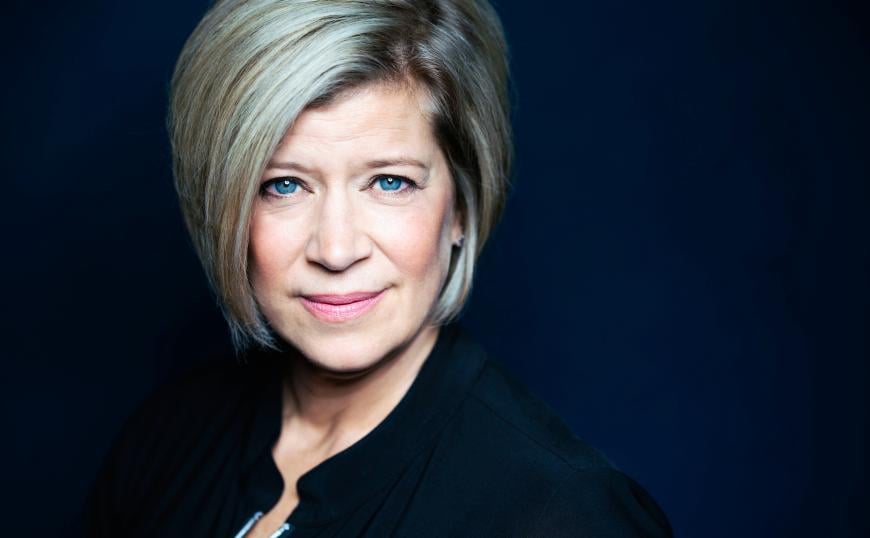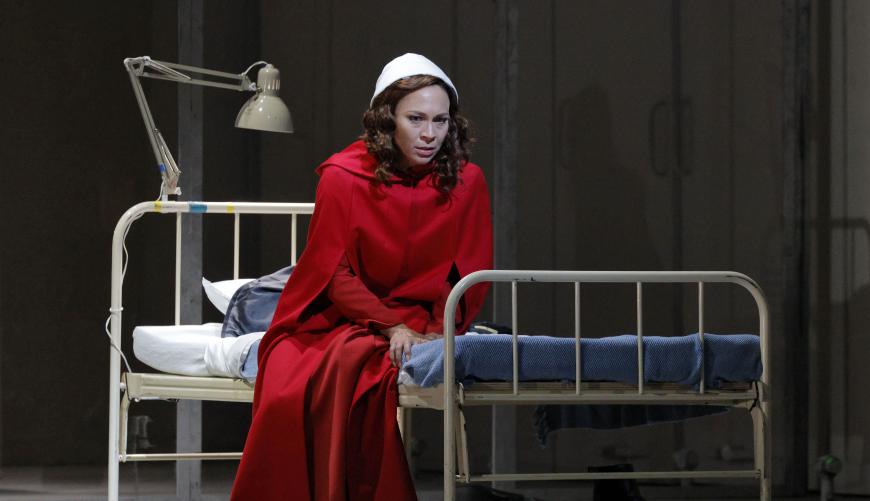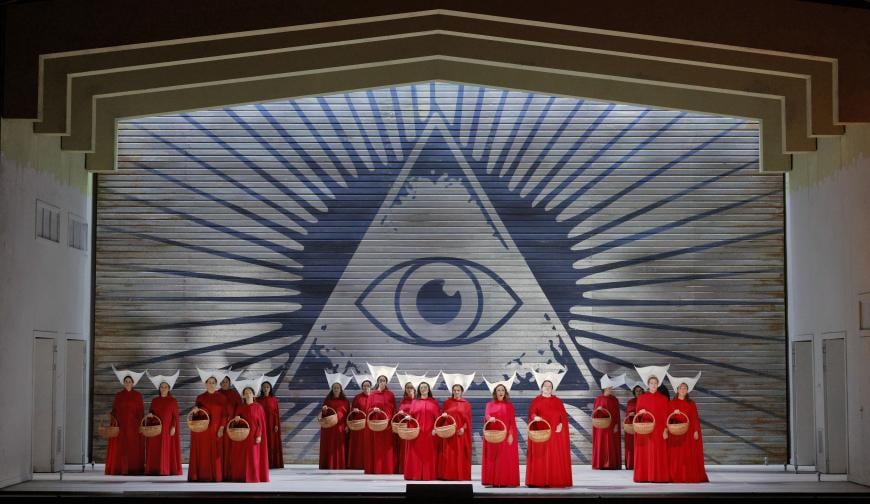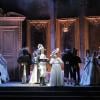
Mezzo-soprano Irene Roberts had to give some thought to taking on her latest role at San Francisco Opera.
In the end, she agreed to play the main character of Offred in the West Coast premiere of Poul Ruders’s The Handmaid’s Tale, running Sept. 14 – Oct. 1 at the War Memorial Opera House. The 1998 opera is based on Margaret Atwood’s dystopian novel of the same name, set in a future where women don’t have the right to read, write, work, or possess property. Some, like Offred, can be forced to leave their families and bear children for others.
“I felt it was a daunting request,” Roberts said of playing the part. “I’m a mother, and I didn’t know if I could handle it.”
The mezzo-soprano explained that while the opera’s music is difficult and complex, she knew she could perform it. The story — and continually repeated phrases like “Praise be,” “Blessed be the fruit,” and “May the Lord open” — were what gave her pause.
“I looked at the text, and I thought, ‘Oh my god, in your native language to sing these words over and over,’” she remembered. “There was just no overestimating the impact that they would have on me.”

Roberts likes a challenge, so she accepted. But she decided that she would need to look after herself when not in rehearsal in order to withstand the emotional toll of the piece. That meant getting a safe, comfortable apartment where she could relax when not at the opera house.
Her colleagues have also offered immeasurable support, she said. They frequently get together on their one-hour lunch break and after the intense rehearsals, and they often go out for beers — just to spend time together.
Roberts, who currently lives in Berlin, grew up in Sacramento and saw her first opera in San Francisco. She has performed at SF Opera in Georges Bizet’s Carmen, Bright Sheng’s Dream of the Red Chamber, Jacques Offenbach’s Les contes d’Hoffmann, and Mozart’s Così fan tutte, and she’s glad to be back. Everyone working with her on the opera has offered kindness and support, she said.
“I can’t tell you how many times people have said, ‘If there’s anything you need, please let us know, whether it’s a snack or a hug or getting you coffee.’ The connection is authentic. Nobody is faking. We’re all really going through a lot, and it’s an authentic desire to have an hour or so after each rehearsal to just connect and joke and have lighthearted contact.”

Karen Kamensek didn’t hesitate when asked to conduct the opera. Not being one to seek out stories of a grim future, she hadn’t read Atwood’s novel or seen the Hulu television series adaptation until offered the job. She calls The Handmaid’s Tale probably the most trying piece she’s ever done but also a spellbinding story.
“To be fair, all operas are pretty misogynistic and violent, if you’re talking about anything that’s not a comic opera, right?” Kamensek said. “But this one is a doozy. It’s a compelling piece of theater from beginning to end. It’s a story that must be told, and we are storytellers.”
Like Roberts, Kamensek is impressed by her colleagues in this production.
“Everybody is so professional and respectful of the material,” the conductor said. “This is a cult story at this point, and it is really a mirror for society to take a look at itself. If you buy a ticket for The Handmaid’s Tale, you know exactly what you’re going to get. You’re going to be entertained, and you’re going to be moved, and you’re going to be triggered, and you’re going to think.”
Kamensek thinks the music is effective in telling the story and setting the mood for this unsettling world. For Roberts, who is onstage the entire opera, it’s different than any other production she’s been in.
“It’s a huge challenge, which I haven’t experienced [before] because the other [operas] I’ve done have had clearer delineations between an aria and a scene,” the singer said. “This [opera] is not that way at all.”

A mark of Kamensek’s dedication to the production has been her lugging around the two huge books that make up the score of The Handmaid’s Tale. She described picking them up and putting them on the piano as the equivalent of a kettlebell routine.
“I feel like I’m doing penance to put this on,” she said. “They’re hardbound, and the two of them together are about 30 pounds. I’m carrying these around, so I feel like I’m really suffering for art at the moment. I’m like, ‘Why do my ribs hurt?’”
The score books may be weighty, but Kamensek is delighted to have them. Before the English National Opera gave them to her, she had purchased a version from a publisher, which turned out to be unusable.
“I cried when I opened the score because the notes were just microscopic,” she said. “I couldn’t read them, even with reading glasses. I thought, ‘There’s no way I can do this.’”
Kamensek, who conducted the Metropolitan Opera premiere of Philip Glass’s Akhnaten in 2019, is known for her work with contemporary and 20th-century composers, but her interests go beyond that.
“I’m a total all-arounder, but I’m labeled as a contemporary-music specialist, a Glass specialist,” she said. “The profession likes to label us. But I enjoy my Mozart, my Puccini, as much as anything else.”

Working on Ruders’s score is challenging, Kamensek said, but she feels she’s making progress. She likens the process to doing a big jigsaw puzzle.
“There’s a lot of sound information. ‘How can I pare that down a little bit?’” she said, describing her preparation. “I think we’re doing a good job of that, of clearing out textures and making it a little slimmer for the public’s ears. This piece is one that’s filled with tone clusters, and I’m trying to diffuse those a little.”
Kamensek’s colleagues tell her she’s extremely calm, which they see as a good thing for this opera.
“It’s scary for everyone with the subject matter, the sound world. And the sound effects that Poul uses disorient people,” she said. “In terms of where the beats are, you can just tell you’re in a world that is off, and people are grasping for straws to gain stability. So I’m trying to find the pulse and the heartbeat of the piece in a way that, just aurally, people can grasp. It is not easy music to grasp, but it is telling the story beautifully.”




